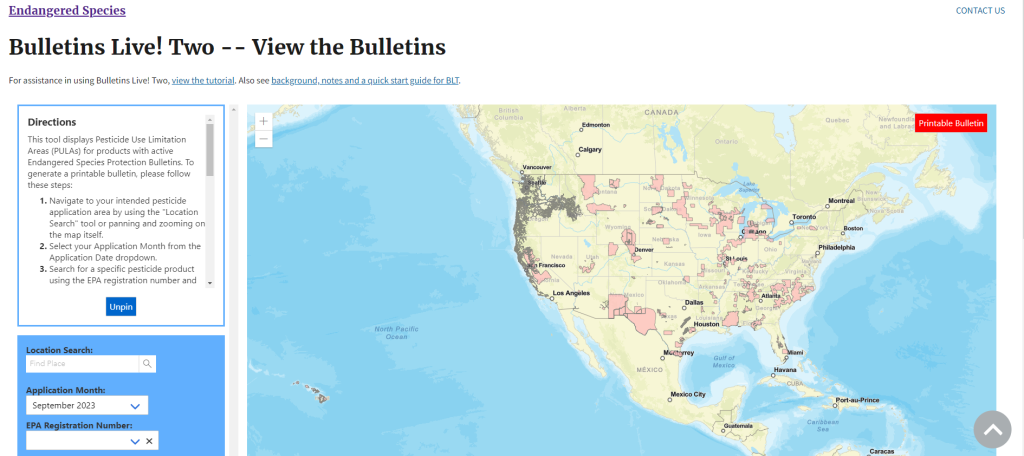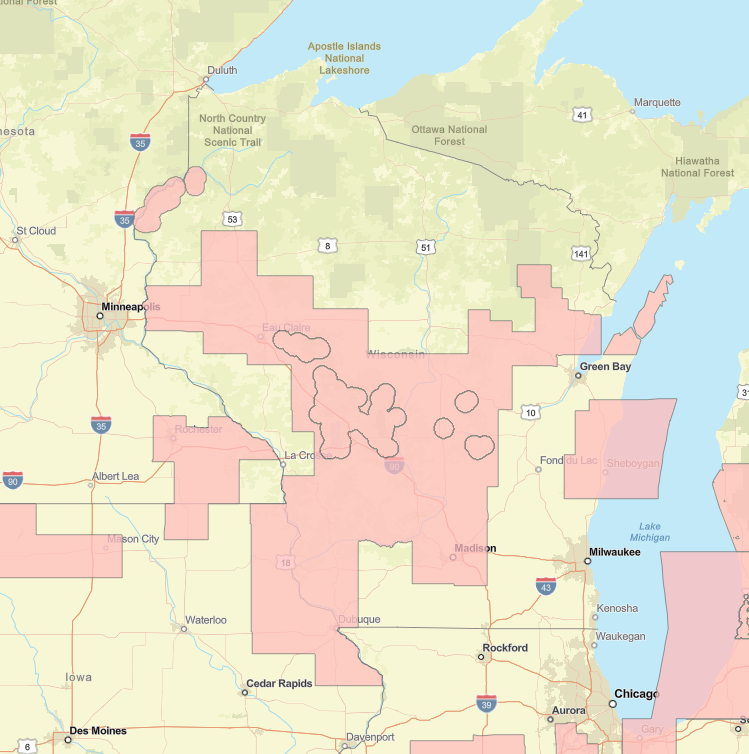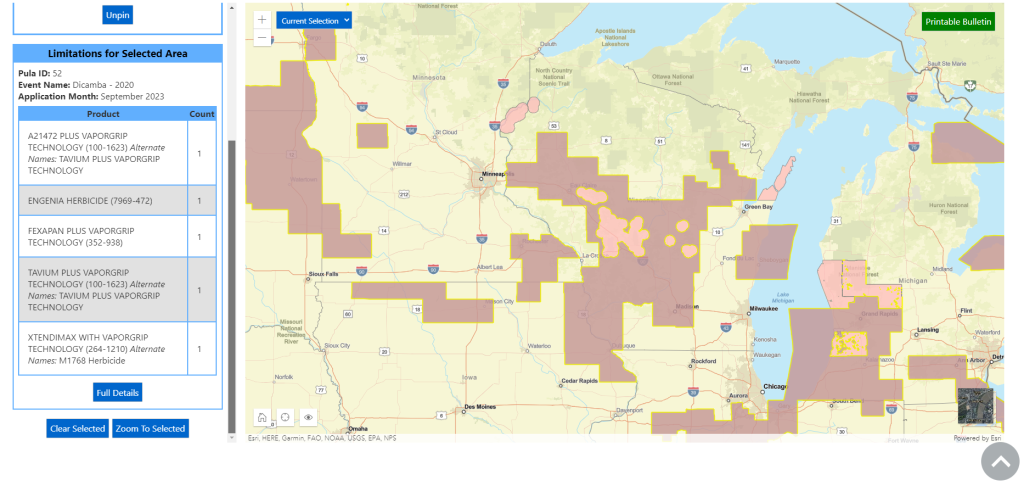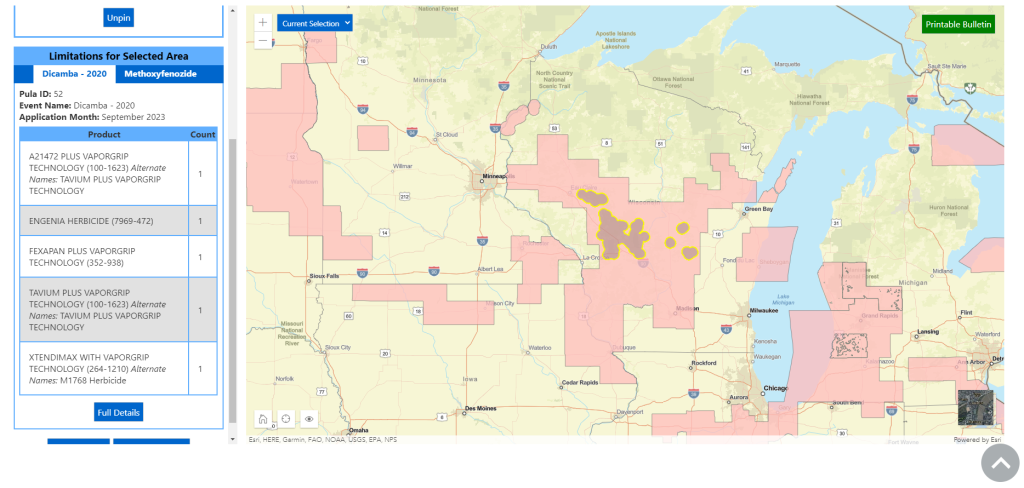The Endangered Species Act (ESA) of 1973 is a large body of law that is designed to protect endangered and threatened species. Sections of this act make the killing, harming, or harassing of these species illegal. As part of this, it also protects the ecosystem that these species depend on because loss of habitat is one of the leading causes of the disappearance of these species
The two main governmental groups charged with administering this law is the U.S. Fish and Wildlife Service (FWS) and the National Marine fisheries Service (NMFS). A large part of their responsibility is to determine and keep a list of species of concern. Below (Table 1, at bottom) is a list of species in Wisconsin that are considered endangered or threatened. Even though the two agencies above are responsible for this law; this Act states that other agencies, for example the Environmental Protection Agency (EPA), have to work towards the same goal.
Part of the EPA’s responsibility is to evaluate the risks of a pesticide’s various uses. They are required to carry this out while complying with the Endangered Species Act. This means that when the EPA registers a pesticide, they have to determine if the use of that pesticide will or will not be likely to cause harm to endangered species or their habitat. This, as you might imagine, can be a complicated and interesting balancing act.
To comply, the EPA uses label requirements and a system called Bulletins Live! Two. Bulletins Live! Two sets up a real time ability to provide additional warnings, requirements, and restrictions that try to mitigate impacts on endangered species and their habitats. For many years, Wisconsin only had one bulletin. Now, there are bulletins for dicamba products labeled for over the top of Xtend® Soybean.
In a recent lawsuit, it was judged that the EPA was not doing enough to comply with the Endangered Species Act. Expect to see more products with bulletins in the future.
How do I get to these bulletins?
Read the Label. Pay particular attention to the Environmental Hazards section of the label. If there is a bulletin for that product, it will provide the link or phone number to “Bulletins Live! Two” (Figure 1.). Figure 1 was taken from a label that has a bulletin. The statement “When using this product, you must follow the measures contained in the Endangered Species Protection Bulletin for the area in which you are applying the product” is present, meaning that compliance is expected. It will then provide the link or phone number to check out the bulletin and what restrictions there might be when using that product.

Follow the Link. When following the link you will see a map of the United States (Figure 2). This map is interactive, being able to zoom in on parts of the country. You can search by location. Assure that the month that you are going to be applying is selected on the left. You can also select by EPA region number, but that would be used mostly by State governments. If you call the number, you can leave a message and someone from the EPA will reach out to you with your requested information. In this front page you can select the month and year of your application. Some bulletins may be time sensitive only showing for specific times of the year.

When applying in Wisconsin, zoom in using the interactive map (Figure 3). At present Wisconsin has 2 bulletins. The first and second bulletins released are the circular areas and the square areas.

pink areas.
Selecting Area. The pink areas are the areas under a bulletin. Clicking these pink areas will provide the information for that specific product and location (Figure 4). In Figure 4, the square edged areas were selected. This presents the information on the left, these are the products that this bulletin applies instructions for. In this example, the dicamba products labeled for over the top application in Xtend® Soybean.

It will only show the bulletin for that area. In this case we only get the dicamba bulletin.
Clicking the circular pink areas gives you a choice between tabs “Dicamba – 2020” and “Methoxyfenozide’s” bulletin in tabs (Figure 5). This is because the two areas overlap.

“Methoxyfenozide.”
Once displaying the bulletin you need, you can click the button “Full Details.” This will display the bulletin for those products (Figure 6). If you are clicking overlapping pink areas, be careful that you are on the correct tab.

computer.
If you scroll down the bulletin you will get a button to click to get a printable bulletin. This provides a printable format that you can have or provide to clients.
Wisconsin presently has two bulletins. The links below will take you to these specific bulletins. Remember bulletins can have time sensitivities and may not apply at all times of the year.
Bulletin for dicamba and methoyfenzide
Although Wisconsin only has two bulletins at the time of writing this post, it is pretty assured that more will be coming. How this will end up and which products will get bulletins is to be determined. The take home message, as always, is read the label before you use the product. Just because a specific product did not tell you to consult a Bulletin last year, that could have changed.
Table 1. List of species in Wisconsin. Taken from US FWS ECOS Environmental Conservation Online System [ Accessed 9/7/2023 ].
| Group | Status | Common Name [ Scientific name ] |
| Bird | Endangered | Piping plover [ Chardrius melodus ] |
| Experimental Pop | Whooping crane [ Crus Americana ] | |
| Threatened | Red knot [ Calidris canutus rufa ] | |
| Clam | Endangered | Higgins eye (perlymussel) [ Lampsillis higginsii ] |
| Endangered | Winged mapleleaf [ Quadrula fragosa ] | |
| Endangered | Spectaclecase [ Cumberlandia monodonta ] | |
| Endangered | Snuffbox mussel [ Epioblasma tiguetra ] | |
| Endangered | Sheepnose mussel [ Plethobasus cyphyus ] | |
| Flowering Plants | Threatened | Northern wild monkshood [ Aconitum noveboracense ] |
| Threatened | Mead’s milkweed [ Asclepias meadii ] | |
| Threatened | Pitcher’s thistle [ Cirsium pitcheri ] | |
| Threatened | Dwarf lake iris [ Iris lacustris ] | |
| Threatened | Prairie bush-clover [ Lespedeza leptostachya ] | |
| Threatened | Fassett’s locoweed [ Oxytropis campestris var. chartacea ] | |
| Threatened | Eastern prairie fringed orchid [ Platanthera leaucophaea ] | |
| Insects | Endangered | Karner Blue butterfly [ Lycaeides melissa samuelis ] |
| Endangered | Hine’s emerald dragonfly [ Somatochlora hineana ] | |
| Endangered | Bog buck moth [ Hemileuca maia menyanthevora ] | |
| Endangered | Poweshiek skipperling [ Oarisma Poweshiek ] | |
| Endangered | Rusty patched bumble bee [ Bombus affinis ] | |
| Mammal | Endangered | Gray wolf [ Canis lupus ] |
| Threatened | Canada lynx [ Lynx Canadensis ] | |
| Endangered | Northern long-eared bat [ Myotis septentrionalis ] | |
| Reptile | Threatended | Eastern rattlesnake [ Sistrurus catenatus ] |
| Snail | Endangered | Iowa Pleistocene snail [ Discus macclintocki ] |




